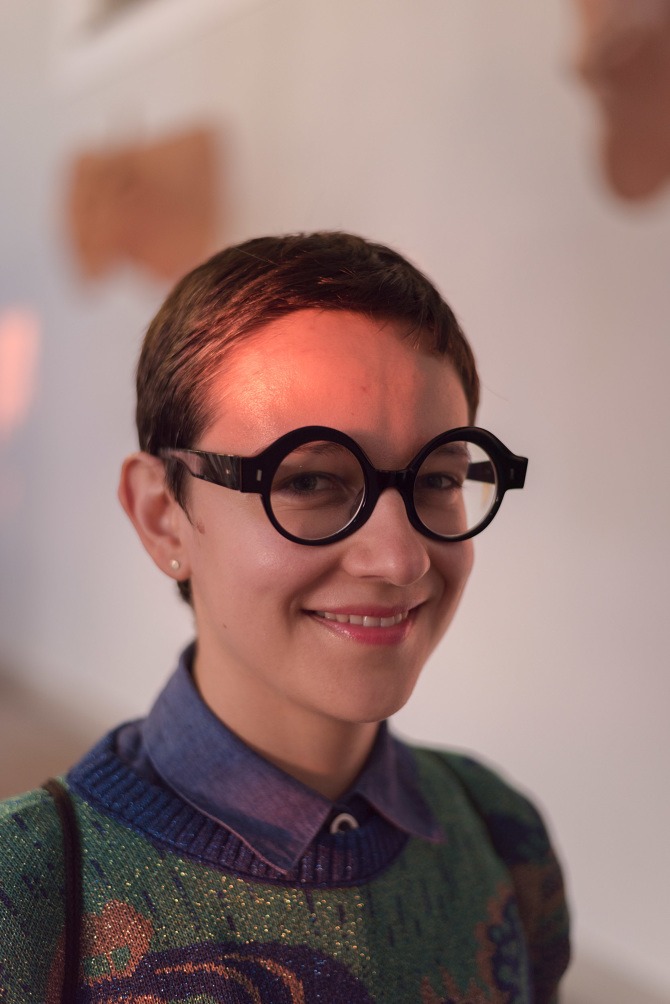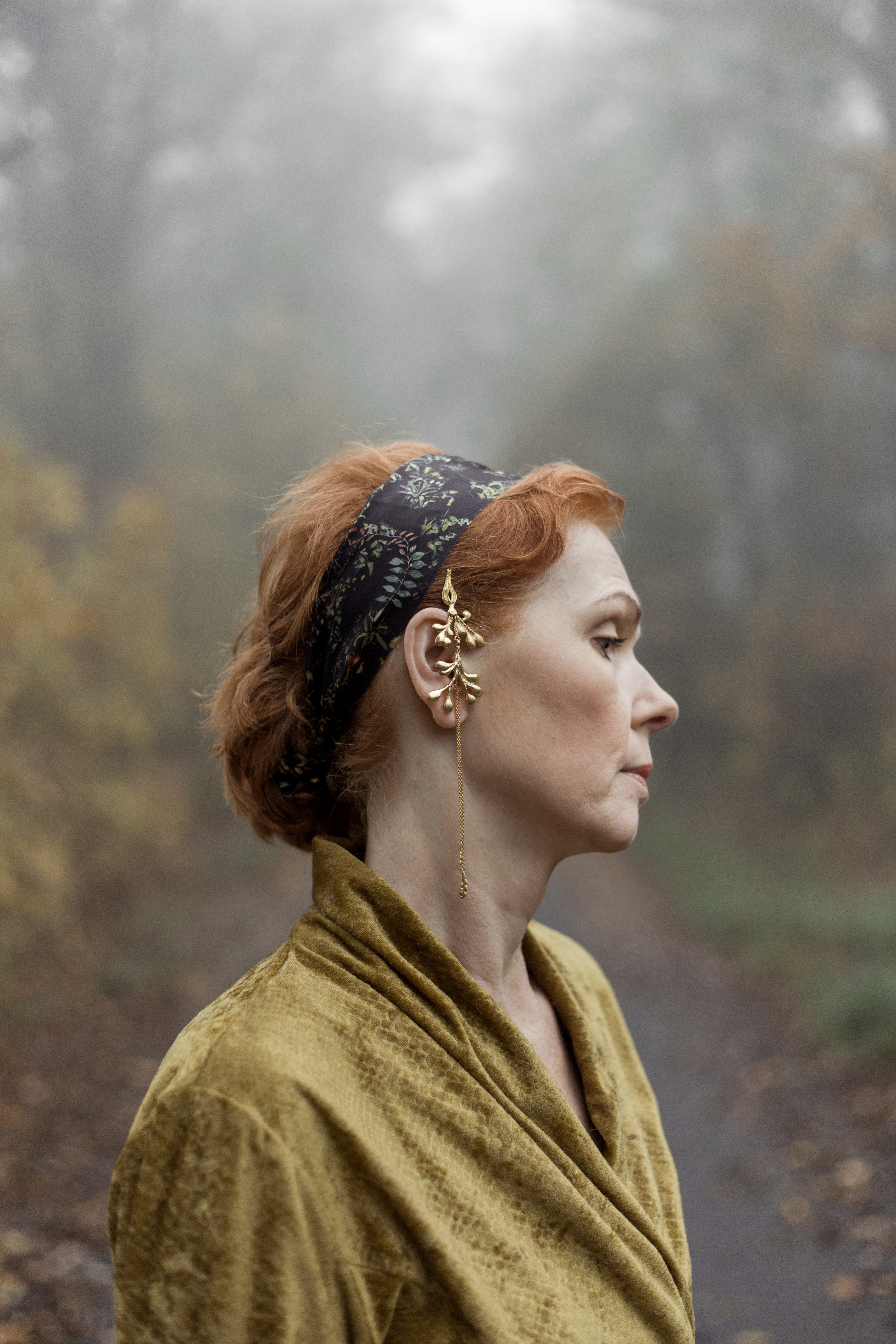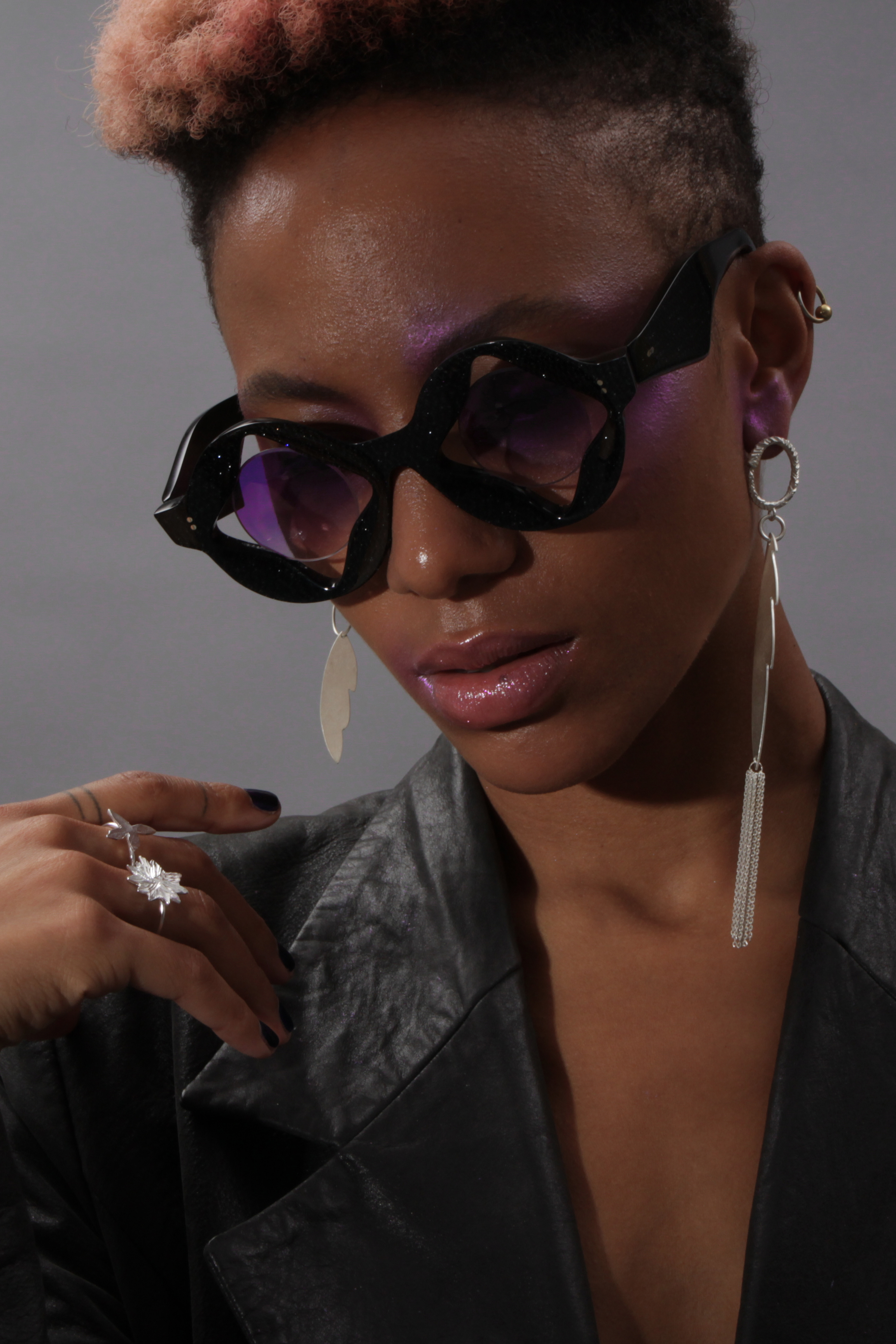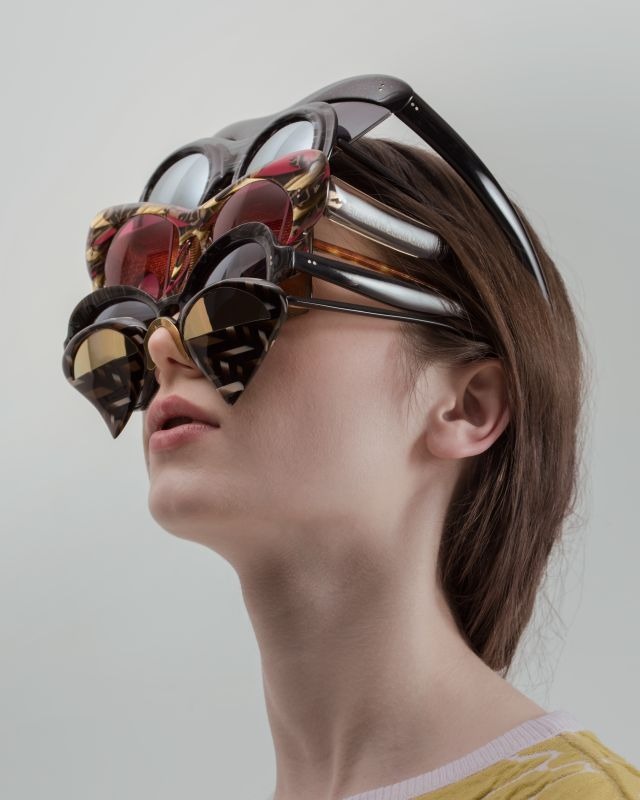Interview / NASTASSIA ALEINIKAVA / It is vital to understand each other
(Slovenčina) Rozhovor s dizajnérkou šperkov a okuliarov Nastassiou Aleinkava. O živote v Prahe, o stratenej identite v Bielorusku, či o spolupráci s IOKO.
The IOKO optic store that has been profiled as a concept store for exceptional design of glasses has lately added a self-conscious limited collection IOKO & NA eyewear. Their authors are Czech-based designer Nastassia Aleinikava, her husband Pavel Kahotski and Dana Prekopová (IOKO). Nastassia Aleinikava is a bold appearance even on the multi-layered Czech designer scene. Her fields are mainly jewellery and eyewear design. Last year she won the highest Grand Designer of the Year award at the Czech Grand Design.

Nastassia Aleinikava, photo: Vojtěch Veškrna.
Your origins are not Czech. How did you find your way to Prague?
Yes, I’m from Belarus. I finished high art school there and then I was looking for some university worth going to. The one in Belarus was far from ideal not only because of the corruption, but also because of the quality of education. Then I tried to go to St. Petersburg, as candidates from the ex-Soviet countries have easier conditions. But I found out that the city was not for me.
Why? Where was it demanding?
It was northern, dark and too big. Complicated transport. It took me one hour and a half to get from the dorm to the uni and I had to change three kinds of transport.
How did you come up with Prague?
I decided for Prague, because I thought it was the most acceptable solution. For example, education is free. My family could not afford to pay a school somewhere in Germany. At the same time, Czech language is a Slavic language, so I decided to master it. From the moment of my decision, I had a feeling that it worked. I found some preparation courses of Czech language in Minsk and then I went through this one-year course at the Charles University. That allowed me to be in Prague and adapt there.
Have you always wanted to study jewellery?
No, originally, I wanted to do textile design. Actually, my first entrance exams were at the textile design department, but they didn’t take me. Then I understood that maybe it just didn’t suit me. After that I started visiting Karol Vratislav Novák for consultations and they were great. He helped me take a decision. So I went to study jewellery. I had had some experience with it already at the high school. We, with my classmate, were doing something Volvo Moskva Fashion Week. But I wasn’t sure back then. Maybe because you can’t really study it in Belarus. It is opened once in five years and it’s rather blacksmithing.
Then you studied at the Eva Eisler’s studio. How do you recall it?
She was really important for me. I’d been accepted by Novák, but then before the start of the school year, she took the studio over. I was actually her first „six-year“ student, i.e. I spent the whole six years with her. And she was super charged with energy and led the studio with gusto from the very beginning. She had just moved from NYC and she passed her experience very generously. The collaborations she struck up during our studies were a great experience for us, too. There was both support and understanding. It was amazing.
How would you compare the cultural environment in Belarus and Prague? How did you reflect the differences? After all, we perceive Belarus as not the most democratic country, with dictatorship features and Lukashenko in charge.
I think media exaggerate a little. I guess they paint Belarus as a bogeyman to cover up for problems here. It’s not so horrible, but yes, it’s not democracy. From my point of view, Belarus had one big problem – the people have lost their identity. Maybe they have even never had it. Belarussians truly do not know who they are, where they belong. The past of being part of the USSR is strong. Naturally, Russians are close to us, but so are Kazachs. We, even younger people than me, perceive the USSR as a country we belonged to. I mean we naturally don’t grieve for the socialist regime, but during these 20 years of freedom, unfortunately under the Lukashenko’s dictate, no environment has risen for seeking a new identity. So that’s what I enjoyed about Czechs at the beginning that I was encountering the word „Czech“ in many unusual places. For example, Czech bread, Czech Christmas. I found it nonsensical – what is Czech bread? Germans have bread, too. Only later did I realise that if we in Belarus named our things in this way, maybe it would empower us as a nation. In our context, it seems more like a swearword. So in my eyes, the biggest problem is the lost identity that the state does not help us find. It’s frozen, history is falsified and it’s not tackled. Here it’s somehow positive, for example, this celebration of 100 years from the birth of the Czechoslovak Republic. Even though we might see a bit cynical approach, the history is really researched, commemorated, people are interested in it and it’s not fudged.

Collection Voynich, photo: Tereza Ondrušková.
And how about a younger generation in Belarus? What about the design and architectural scene there? How do you see it?
It has changed a lot during my time here. Who has some money, travels. It’s very positive, as then they come back and change it there. Minsk is a standard European city, of course with a tinge of Soviet past, but there is a rather intense night life. Inspiration comes from Berlin. Design is also developing in some way, but I’d like that Belarusians drew more from their authenticity; a great number of things are just plain copies. I don’t see too many original thoughts in there. It’s also miserable in terms of architecture. Mostly we see some kind of Turkish, non-original style. Though one can find more interesting realisations somewhere among private buildings. If I had to mention somebody, it would be the brand of leather accessories Kill today. It’s a lady that makes quite intriguing handbags.
How did you adapt to the professional reality after the university? Did anything catch you by surprise?
The transition was really smooth, as I tried to be visible since my third grade. We were exhibiting, taking part in different designer supermarkets both as a studio or individually, step by step getting some customers. I had my studio minus school, so there was more time for self-promotion. A major breakthrough was my thesis that covered glasses. All of a sudden it was something completely different. I had to learn a lot of things, because it required different technologies, materials. I split my work into jewellery and eyewear a little.

Collection Comets, photo: Taja Spasskova.
Is it still like that?
At the moment, I deal with glasses only minimally. My husband (Pavel Kahotski) is more in charge, he also leads the custom-made production, mainly made-to-measure glasses. I wasn’t planning it at all, but after several Designbloks (Prague’s design exhibition) where we were showing them, the number of orders significantly rose. People wanted bespoke glasses. We were lacking a firm production technology, there were many technical problems. It was all too much, so I had to start regulating it. Pavel was standing by me from the start and even though he studied film and TV graphic, it turned out it was suitable. For example, I found out how computer programs together with graphic design are important for designing.
What materials do your use with your eyewear?
We only work with cellulose acetate by Mazzucchelli. It’s a type of material from Italy that has been made in one family company for 150 years. They are nearly the last of their kind in Europe. We work with it in quite a sculptural manner. First there is CNC lathe and 2D cut, that’s true, but then we finish it and form manually. So, each piece is an original.
What’s the hardest about designing eyewear?
I guess the most demanding part is a good communication with a client. To understand each other well. What he/she really wants. Some people are like blind kittens. They see a plate of material, but they can’t imagine it. So, I have to explain them everything from scratch.
How do you view the difference between working with jewellery and eyewear? Do you collaborate with fashion designers?
It’s very similar, for instance, with regards to tools. Naturally, I transfer many structures and surfaces I have on my jewellery into glasses. Each material requires different modelling. Usually it’s created on the go. For example, last time our glasses were part of the new campaign of Preciosa components. I find fashion more demanding. It’s very quick and jewellery needs time to be functional. To get to grips with wearability. It happened in collaboration with fashion designers that at the moment when they were finishing their collection, I was only at the start. We were totally out of sync. I have to have time. I want my collection to be able to live its own life. I don’t want it to finish with one season only. Then I have a feeling it’s merely an accessory. Junk jewellery.
Last year you received the main award at the Czech Grand Design. Both for jewellery (the Utopia collection) and eyewear design. What followed?
Mostly intense medialisation, also from the media that wouldn’t take notice of me before. And they were also writing about me in Belarus. Maybe there also was an interest of new clients, but I had worked with many of them even before, so for them it was also a kind of satisfaction that their choice was right.
That was also the case of collaboration with Dana Prekopová and IOKO brand. What do you think of her?
We had been checking each other for long. When I was doing my thesis, a FB account of IOKO was an interesting source of good and high-quality brands. Dana Prekopová noticed me too and many people referred her to us. So when we finally met, we were talking about glasses for four hours. She has many experiences from fairs and looks at things from a different angle. At the end of the meeting, Pavel said: „Let’s do something together. And Dana P. was happy because she had been wanting to initiate something like that for a longer time. To have an own collection.

IOKO x Nastassia Aleinikava Eyewear Lookbook 2018, photo: Patricia Kvasnovska, styling: Nina Ford, muse: Ingrid Timková.

IOKO x Nastassia Aleinikava Eyewear Lookbook 2018, photo: Patricia Kvasnovska, styling: Nina Ford, muse: Ingrid Timková.
Did you learn something new from this collaboration?
Yes, it was probably the most rapid insight into new technologies. We also learned many invisible things. Unwritten rules that Dana Prekopová knows from practice. The choice of materials was also different. We wouldn’t have come up with the material she chose at the start. But at the end of the day we saw it was good and that she had a great imagination. I guess this collaboration hasn’t ended yet. We’ve met both personally and professionally. Great!
Who do you respect on the scene of glasses production in the world?
I admired Rigards a lot, he is a guy from Asia who founded a brand in California and worked a lot with horn. I like how he works in a sculptural manner and there is a lot of Asian influences too. His glasses are completely different from other designers. Now he made a couple of aluminium collections, but I don’t like them too much. Pavel and I have a favourite NY master Wesley Night who handmakes glasses. He also works with horn and his glasses are these classic, discreet pieces. He has a small workshop and makes videos about the creation, which we enjoy. We observed his procedure and looked at what he had in his workshop. We are his fans. And he makes them in a similar way, including the custom-made glasses. And of course, we like a half of the IOKO’s offer. They are glasses from small, often family companies that you barely have a chance to see elsewhere.
And at the end, how long have you worn glasses?
Since I was 11 and my vision is so bad that I can’t wear lenses. Glasses are a part of me and I don’t put them down.
And how many do you have?
Just one pair. It’s not cheap. The lenses were expensive.

Collection Utopia, photo: Vojtěch Veškrna.